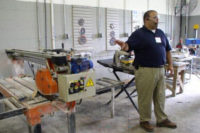
We all know that the increase in natural stone consumption in the U.S. has been remarkable over the past few years. The use of stone products - particularly in a slab format - has been exploding, as homeowners are considering granite kitchen countertops to be a staple of their residential projects. However, rise in slab consumption - coupled with the increase in new companies dealing with slabs - has led to a major issue that our industry needs to face: SAFETY.
Far too often, we are hearing about workers in our industry being hurt or killed by falling slabs, and it is time for this to stop. There are enough sources of information on proper material handling out there - including a myriad of materials from the Marble Institute of America - that ALL of the people working in our industry can be educated.
My take on the situation is this: most shop and warehouse owners and managers seem to have invested in the right handling equipment and storage racks, and they generally understand proper material handling. However, their employees - the ones who are actually maneuvering the material - are often sorely lacking in this knowledge, and this is the area that needs to be addressed.
Anyone who operates a warehouse or fabrication shop (or any other business, for that matter) will tell you that finding and retaining employees is the toughest challenge in running their operation. And very often, stone companies are finding that the best workers are ones without any experience in the stone industry at all. They haven't picked up any bad habits, and so they can learn a company's way of doing business with a clean slate.
However, workers who are new to our industry can have a very difficult time understanding just how heavy - and dangerous - a slab can be. I have literally been to hundreds of fabrication shops, plants and warehouses around the world, and when I see slabs being lifted, I am always amazed at how “light†they seem. Whether the operation is using overhead cranes, forklifts, clamps or vacuum lifters, the slabs seem to be maneuvered effortlessly, and they are guided into place with a minimum of human labor and strength. Given that point of view, it is difficult for newcomers to the industry to get an illustration of just how dangerous slabs can be. It is critical for the managers of stone warehouses and shops to make sure that all of their employees - new and old - understand exactly how to handle slab materials. It's not just a matter of saying, “Two men on a slab at all times,†and that's it. Everyone needs to know exactly how the crane works, how the clamps work, how the vacuum lifters work. They need to know that they should NOT try to save a falling slab.
Of course, since I am not actually working in the stone industry, those points are just the very basics. There are many sources of information on shop safety in general and material handling in particular. As I said earlier, the Marble Institute of America is at the forefront of this initiative, and they produce educational material in both English and Spanish. They have produced videos, posters and manuals on safety and material handling, and frankly, many of their educational tools (or at least similar tools) should be mandatory for any operation dealing with slab materials. When a new employee starts, he watches the video, he reads the manual, and he takes a test before he can begin working. No exceptions. And the posters should hang on the wall as a constant reminder that this can be a deadly business when the proper procedures are not followed.
While we're at it, the salespeople walking around the warehouse need a primer on material handling as well. Many times, they're walking homeowners around a warehouse full of slabs, and so they need to understand how dangerous a slab can be as much as anyone else.
For more information on the Marble Institute's safety education materials, visit www.marble-institute.com and check out their “Bookstore†link. You'll find a broad array of resources under the “Health and Safety†category. It's well worth the investment. And once you've made the investment, share this knowledge with your employees. You'll be glad you did.


